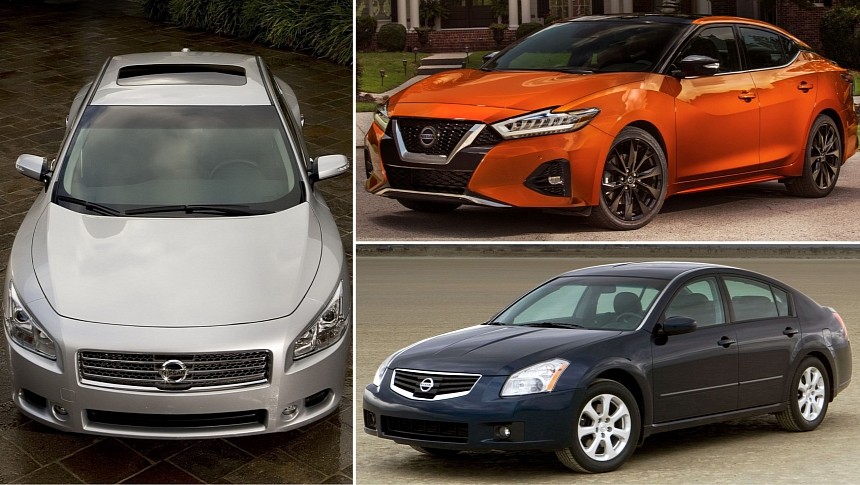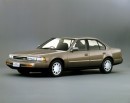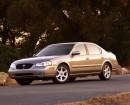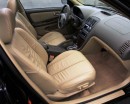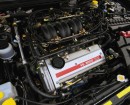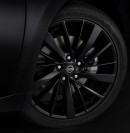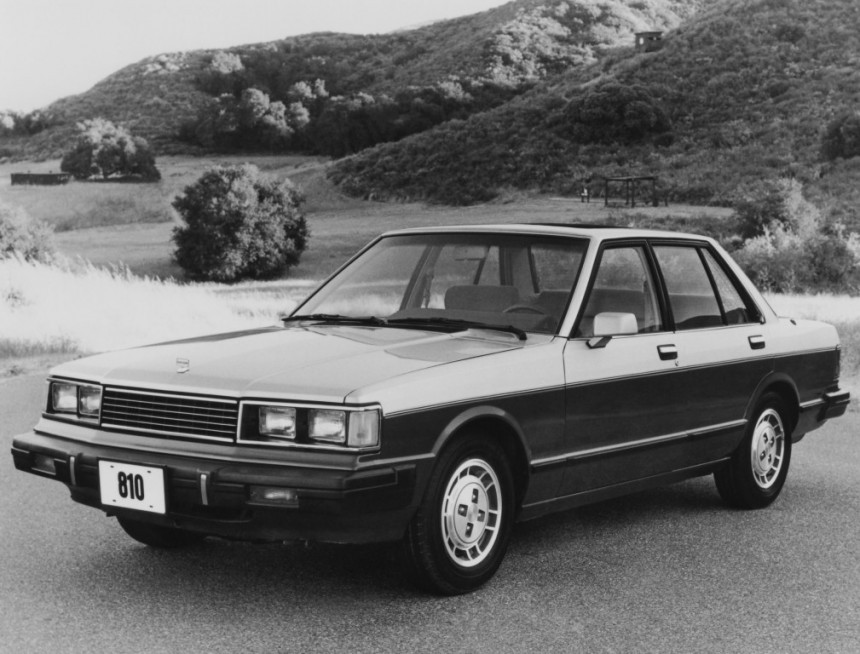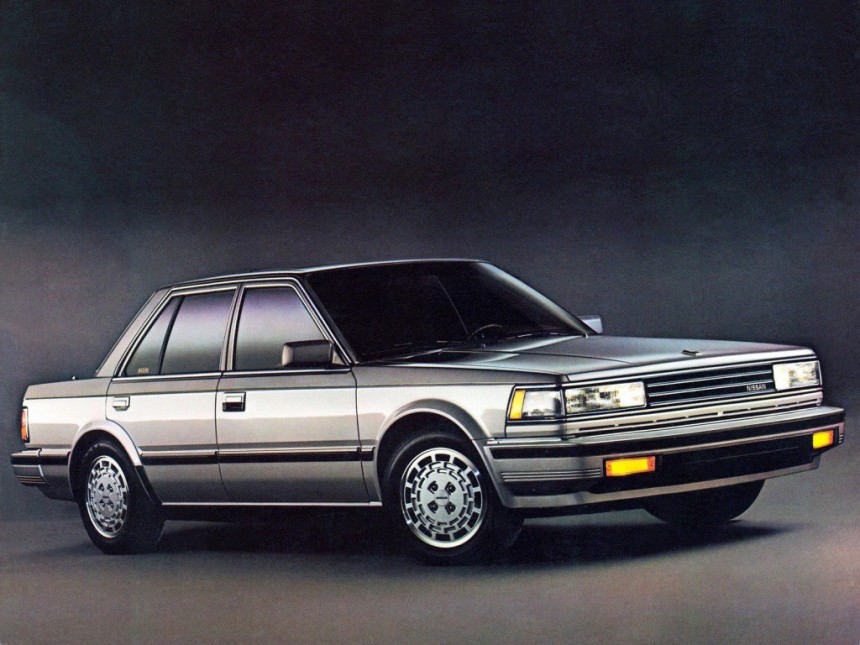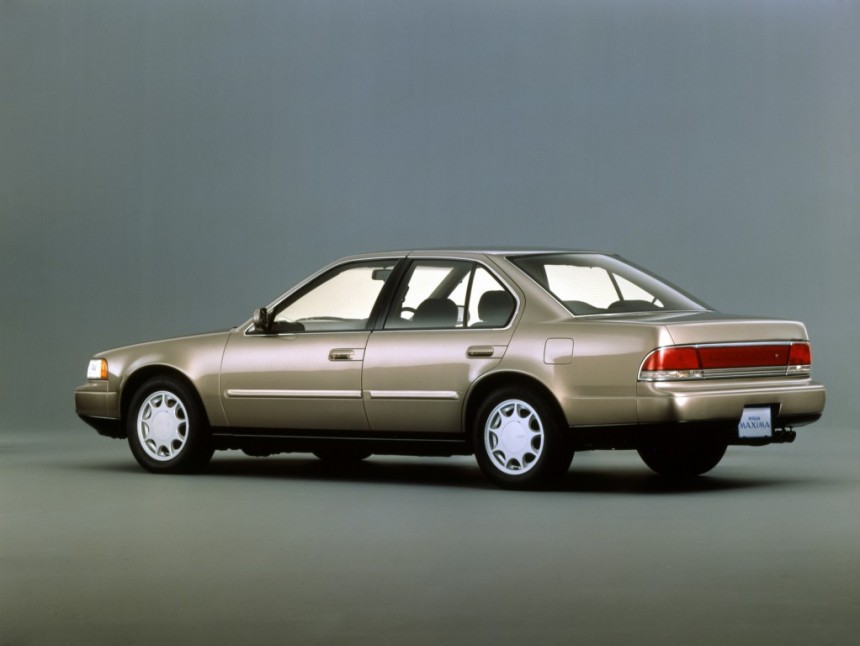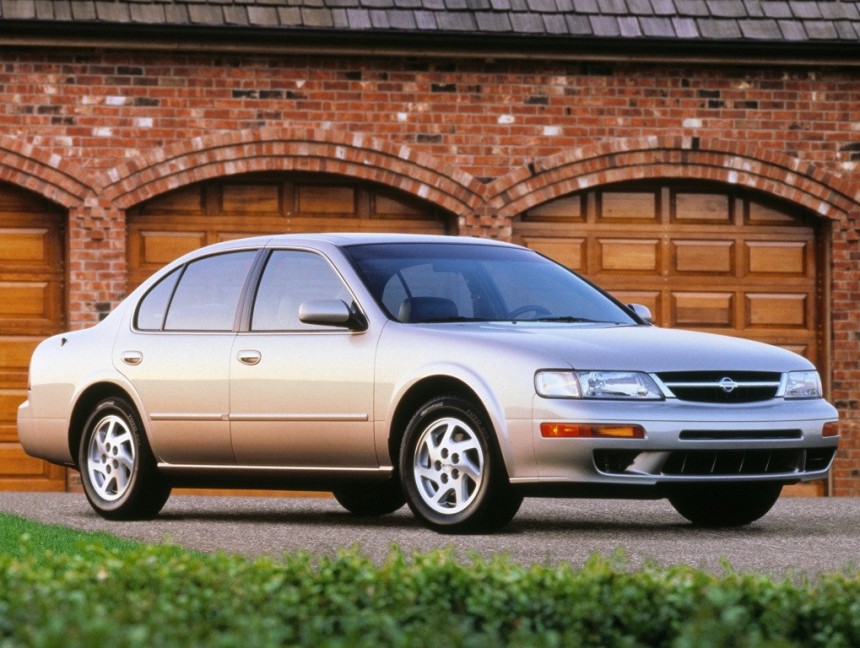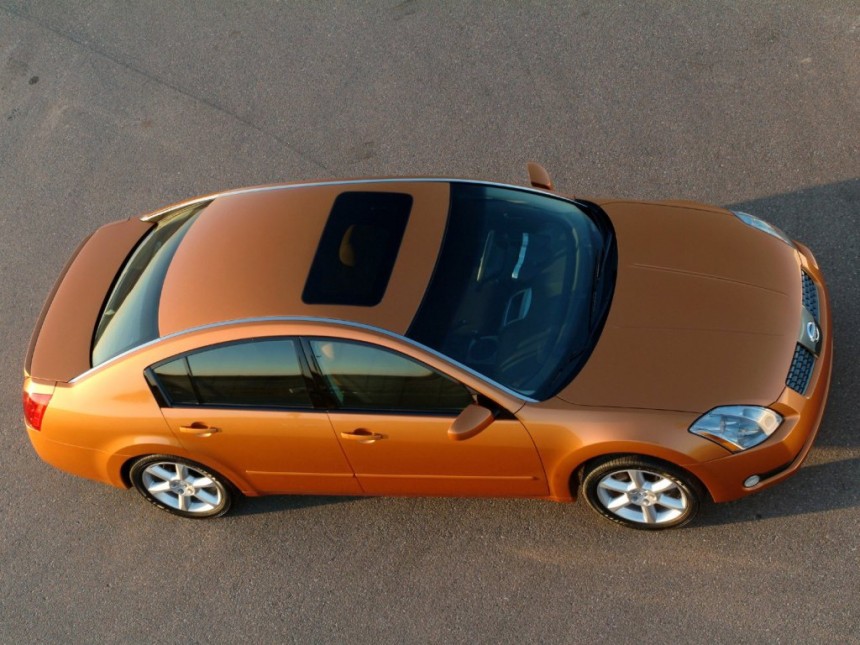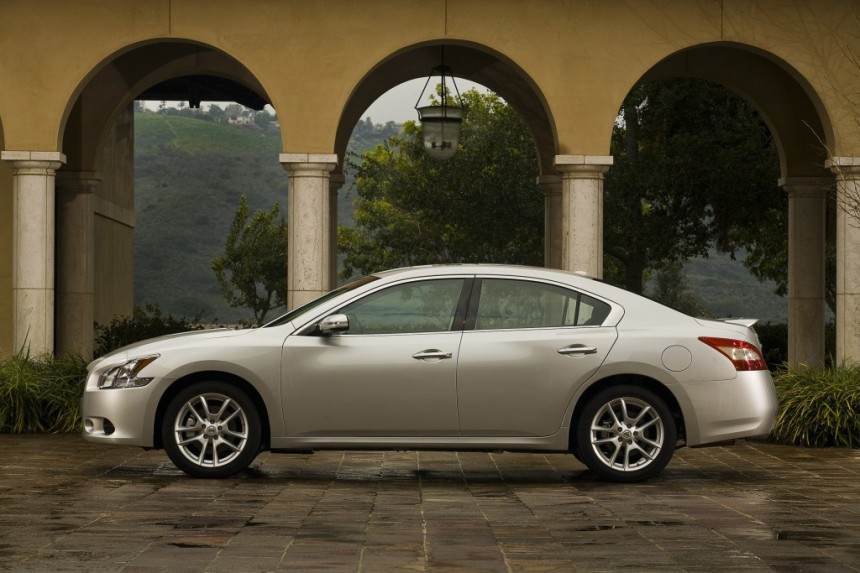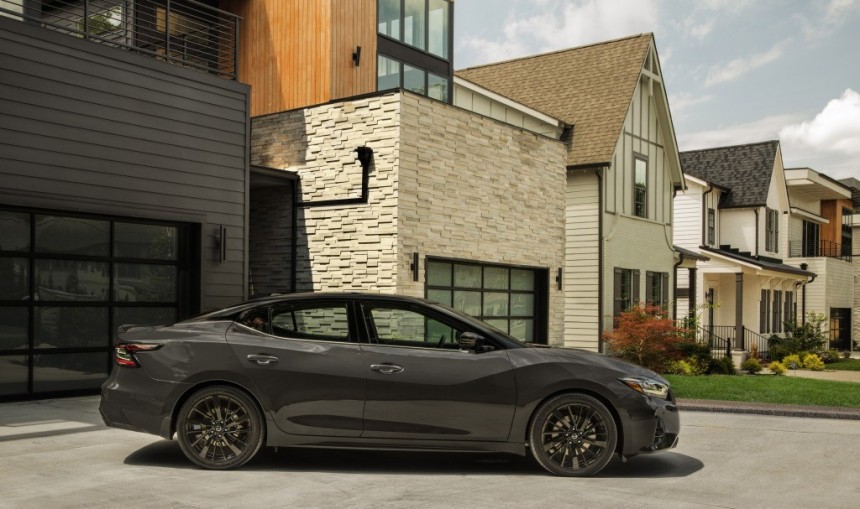Back in the 1970s, Japanese automaker Nissan rolled out a Datsun-badged model by the name of 810. Closely related to the Bluebird, the first gen came in the guise of a sedan, wagon, and hard-topped coupe. Derived from the 910-series Bluebird, the 810 became the Maxima in 1981 for MY82.
One of the Japanese automaker's longest-running nameplates, the Maxima currently serves as the Japanese automaker's flagship car. Nissan even rolled out a 40th anniversary edition for the 2021 model year, but alas, the full-size sedan will be retired after model year 2023.
How has it come to this? Once billed as a four-door sports car due to its 240Z-sourced powerplant, the Maxima slowly yet steadily morphed into a rather boring vehicle. Even by rental car standards, the eighth and final generation is as dull as it can be. Duller than Roman senator Cato the Younger filibustering Julius Caesar's land reform due to a chronic lack of any proper justification to oppose the distribution of public lands to Rome's poor citizens and Pompey Magnus' veterans.
From a high point of 163,138 deliveries in the United States market in 1994, the Maxima downturned to 7,110 sales in 2022. Sedans may not be as popular as they once were due to a surge in demand for crossovers. On the other hand, remember that Toyota moved 295,201 Camrys in 2022.
That being said, let's take a look at how Nissan started so well with the Maxima, then dropped the ball due to factors within and outside its control.
A more complete package than the short-lived Stanza Maxima, the 910-series Maxima launched as the 810 Deluxe and 810 Maxima in the United States. Marketed as the Datsun Maxima from 1981 onward, the original was available as a four-door sedan and five-door wagon.
It was during this period that Datsuns were being rebranded as Nissans in North America and elsewhere. Maxima switched to Nissan badging in 1983 for 1984, its final model year of production. Competing with mid-sized cars that North America considered as compacts back then, the Maxima could be had with the L24E straight-six engine of the 240Z or – get this – a diesel engine.
The LD28 failed miserably in this part of the world, partly due to abysmal performance and partly due to using a similar main bearing block design as the L28 gasser. Produced in Japan, Taiwan, and Australia, the first generation had independent rear suspension for the sedan and a live axle for the more practical longroof.
Transitioning from rear- to front-wheel drive, the Maxima entered its second generation in 1984 for the 1985 model year under the PU11 codename. Based on the Bluebird U11, the second coming adopted a transverse-mounted V6. It was also the final Maxima to be offered as a station wagon. Still a compact, the PU11 was designed specifically with the US of A in mind.
Wheelbase increased from 99.4 to 100.4 inches, which converts to 2.52 and 2.55 meters for those who prefer the metric system. Also available as a pillarless hardtop in Japan, the Maxima featured three powertrain choices in this period. The Japanese domestic market received naturally-aspirated and turbocharged V6s, with the former making nearly 120 ponies and the latter 170.
North America received the VG30E, a naturally-aspirated sixer from the same engine family as the aforementioned 2.0-liter mills. The 3.0-liter V6 intended for export markets produced a respectable 152 horsepower and 167 pound-feet (226 Nm) of torque.
The changeover from Gen 2 to Gen 3 saw the Maxima sell a whopping 74,451 units in the United States of America. That may not seem like much, but remember that Toyota sold 14,195 copies of the Cressida that year. The Maxima got even better with the third generation, the one that Nissan billed as a four-door sport car.
Now categorized as a midsizer, the sedan-only Maxima received the internal designation J30. Equipped with a window decal that reads 4DSC for four-door sports car, the Gen 3 was briefly offered in Japan as well. Following the 1991 facelift for model year 1992, the Maxima was unceremoniously canned in its domestic market.
Once again, the VG30E served as the base engine. The Maxima SE received a thoroughly improved version of the VG30E – dubbed VE30DE – with dual overhead cams, more valves, a variable intake manifold, variable valve timing, and timing chains rather than belts.
The second Japanese mid-size sedan in North America after the Mazda 929 was replaced by the Gen 4 in 1994 for the 1995 model year. Known as the Cefiro in Japan and QX in the United Kingdom, this generation's primary competitor was the Cressida-replacing Avalon that Toyota discontinued after the 2022 model year.
Codenamed A32, the Maxima from this era was dimensionally similar to its predecessor. It grew marginally longer in length, wheelbase, width, and height, yet Nissan still decided to cut production costs in one key area. Rather than an independent rear suspension, the Maxima switched to a torsion bar.
The more archaic suspension helped the Maxima shed a few pounds over its predecessor. Also produced by South Korea's Samsung Motors under the SM5 moniker, the Maxima was offered with either the VQ20DE or VQ30DE, with the latter belting out 190 horsepower and 205 pound-feet (278 Nm) of torque at 4,000 rpm.
Jerry Hirshberg penned the A33B at Nissan's design studio in La Jolla. Twinned with the Cefiro for Japan and QX for Europe, this generation was assembled at the Oppama plant in Yokosuka, like all previous Maximas.
Closely related to the Infiniti I30 and more powerful I35, the A33B launched with a 3.0-liter V6 good for 222 horsepower on full song. 2002 model year updates included the VQ35, namely the VQ35DE with 255 ponies and 246 pound-feet (334 Nm) on tap. As you're well aware, the 350Z also used the 3.5-liter V6 lump.
Gen 5 production ended in late 2002 with the 2003 model year. The Gen 6 came exclusively with the aforementioned six-cylinder mill, and for the first time in the Maxima's history, it was produced in the USA.
Manufactured at the Smyrna Assembly Plant in Tennessee, the Jerry Hirshberg-designed A34 is based on a stretched version of the Altima's platform. The FF-L would be replaced by the Renault-Nissan Alliance's D platform for the seventh- and eighth-gen Maxima.
The Japanese automaker marketed the A34 as a more premium affair than the preceding Maximas. In truth, cash-stripped Nissan cut a few corners in terms of interior plastics and quality control. The cost-cutting culture was in full swing at Nissan thanks to Carlos Ghosn, the man who saved and made Nissan worse at the same time by aggressively cutting costs to keep investors happy.
Equipped with a glass-paneled roof as standard, the A34 transitioned to a continuously variable transmission for 2007. CVTs are less expensive to make than torque-converter automatic trannies, and that generation of the Xtronic CVT is notoriously riddled with problems.
Gen 7 was a step in the right direction from a stylistic standpoint, dropping the hunchback-esque aesthetic of the A34 in favor of a traditional roofline. Decidedly sporty up front, the A35 rides on the D platform introduced by the Laguna and Murano back in 2007.
Nissan thankfully revised the Xtronic CVT, and it also bumped up the output of the VQ35DE from 265 horsepower and 255 pound-feet (346 Nm) to 290 horsepower and 261 pound-feet (354 Nm). Modestly refreshed for the 2012 model year, the Maxima was expected to gain a diesel for 2010. Looking back at the slow-selling LD28 of the first generation, the Japanese automaker eventually decided against this new diesel.
Another reason for canceling said powerplant is – of course – the financial crisis brought by the housing bubble bursting in grand fashion. As a brief refresher, General Motors and Chrysler had to file for Chapter 11 bankruptcy. As opposed to the biggest of the Big Three in Detroit and Chrysler, the Ford Motor Company weathered said crisis without filing for bankruptcy.
The A35 topped 60,569 sales in the United States in 2010, which led many to question whether the A36 would be the last-ever Maxima. Even though sales improved to 67,627 in 2017, the writing was on the wall. Nissan axed the Maxima in Mexico after MY20, then confirmed the inevitable for the US of A and Canada in August 2022 after MY23 due to increasingly poor sales numbers.
Manufactured in both China and the United States, the A36 is pompously described as a four-door sports car despite not being anything close to such a thing. On the upside, it's the safest, techiest, and most refined Maxima to date despite the venerable age of the D platform.
Back in February 2022, the Japanese automaker previewed two all-electric sedans from the Nissan and Infiniti brands. Scheduled to enter production in 2025 at the Canton plant in Mississippi, these EVs will be joined by 13 more siblings by 2030. One of those two sedan-styled EVs is believed to resurrect the Maxima nameplate, but only time will tell if Nissan eventually chooses brand equity over a lackluster moniker like Ariya.
How has it come to this? Once billed as a four-door sports car due to its 240Z-sourced powerplant, the Maxima slowly yet steadily morphed into a rather boring vehicle. Even by rental car standards, the eighth and final generation is as dull as it can be. Duller than Roman senator Cato the Younger filibustering Julius Caesar's land reform due to a chronic lack of any proper justification to oppose the distribution of public lands to Rome's poor citizens and Pompey Magnus' veterans.
From a high point of 163,138 deliveries in the United States market in 1994, the Maxima downturned to 7,110 sales in 2022. Sedans may not be as popular as they once were due to a surge in demand for crossovers. On the other hand, remember that Toyota moved 295,201 Camrys in 2022.
That being said, let's take a look at how Nissan started so well with the Maxima, then dropped the ball due to factors within and outside its control.
Nissan Maxima Gen 1
It was during this period that Datsuns were being rebranded as Nissans in North America and elsewhere. Maxima switched to Nissan badging in 1983 for 1984, its final model year of production. Competing with mid-sized cars that North America considered as compacts back then, the Maxima could be had with the L24E straight-six engine of the 240Z or – get this – a diesel engine.
The LD28 failed miserably in this part of the world, partly due to abysmal performance and partly due to using a similar main bearing block design as the L28 gasser. Produced in Japan, Taiwan, and Australia, the first generation had independent rear suspension for the sedan and a live axle for the more practical longroof.
Nissan Maxima Gen 2
Wheelbase increased from 99.4 to 100.4 inches, which converts to 2.52 and 2.55 meters for those who prefer the metric system. Also available as a pillarless hardtop in Japan, the Maxima featured three powertrain choices in this period. The Japanese domestic market received naturally-aspirated and turbocharged V6s, with the former making nearly 120 ponies and the latter 170.
North America received the VG30E, a naturally-aspirated sixer from the same engine family as the aforementioned 2.0-liter mills. The 3.0-liter V6 intended for export markets produced a respectable 152 horsepower and 167 pound-feet (226 Nm) of torque.
Nissan Maxima Gen 3
Now categorized as a midsizer, the sedan-only Maxima received the internal designation J30. Equipped with a window decal that reads 4DSC for four-door sports car, the Gen 3 was briefly offered in Japan as well. Following the 1991 facelift for model year 1992, the Maxima was unceremoniously canned in its domestic market.
Once again, the VG30E served as the base engine. The Maxima SE received a thoroughly improved version of the VG30E – dubbed VE30DE – with dual overhead cams, more valves, a variable intake manifold, variable valve timing, and timing chains rather than belts.
Nissan Maxima Gen 4
Codenamed A32, the Maxima from this era was dimensionally similar to its predecessor. It grew marginally longer in length, wheelbase, width, and height, yet Nissan still decided to cut production costs in one key area. Rather than an independent rear suspension, the Maxima switched to a torsion bar.
The more archaic suspension helped the Maxima shed a few pounds over its predecessor. Also produced by South Korea's Samsung Motors under the SM5 moniker, the Maxima was offered with either the VQ20DE or VQ30DE, with the latter belting out 190 horsepower and 205 pound-feet (278 Nm) of torque at 4,000 rpm.
Nissan Maxima Gen 5
Closely related to the Infiniti I30 and more powerful I35, the A33B launched with a 3.0-liter V6 good for 222 horsepower on full song. 2002 model year updates included the VQ35, namely the VQ35DE with 255 ponies and 246 pound-feet (334 Nm) on tap. As you're well aware, the 350Z also used the 3.5-liter V6 lump.
Gen 5 production ended in late 2002 with the 2003 model year. The Gen 6 came exclusively with the aforementioned six-cylinder mill, and for the first time in the Maxima's history, it was produced in the USA.
Nissan Maxima Gen 6
The Japanese automaker marketed the A34 as a more premium affair than the preceding Maximas. In truth, cash-stripped Nissan cut a few corners in terms of interior plastics and quality control. The cost-cutting culture was in full swing at Nissan thanks to Carlos Ghosn, the man who saved and made Nissan worse at the same time by aggressively cutting costs to keep investors happy.
Equipped with a glass-paneled roof as standard, the A34 transitioned to a continuously variable transmission for 2007. CVTs are less expensive to make than torque-converter automatic trannies, and that generation of the Xtronic CVT is notoriously riddled with problems.
Nissan Maxima Gen 7
Nissan thankfully revised the Xtronic CVT, and it also bumped up the output of the VQ35DE from 265 horsepower and 255 pound-feet (346 Nm) to 290 horsepower and 261 pound-feet (354 Nm). Modestly refreshed for the 2012 model year, the Maxima was expected to gain a diesel for 2010. Looking back at the slow-selling LD28 of the first generation, the Japanese automaker eventually decided against this new diesel.
Another reason for canceling said powerplant is – of course – the financial crisis brought by the housing bubble bursting in grand fashion. As a brief refresher, General Motors and Chrysler had to file for Chapter 11 bankruptcy. As opposed to the biggest of the Big Three in Detroit and Chrysler, the Ford Motor Company weathered said crisis without filing for bankruptcy.
Nissan Maxima Gen 8
Manufactured in both China and the United States, the A36 is pompously described as a four-door sports car despite not being anything close to such a thing. On the upside, it's the safest, techiest, and most refined Maxima to date despite the venerable age of the D platform.
Back in February 2022, the Japanese automaker previewed two all-electric sedans from the Nissan and Infiniti brands. Scheduled to enter production in 2025 at the Canton plant in Mississippi, these EVs will be joined by 13 more siblings by 2030. One of those two sedan-styled EVs is believed to resurrect the Maxima nameplate, but only time will tell if Nissan eventually chooses brand equity over a lackluster moniker like Ariya.
